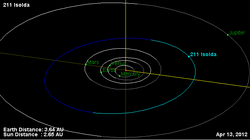Astronomy:211 Isolda
From HandWiki
Short description: Main-belt asteroid
 Orbital diagram | |
| Discovery | |
|---|---|
| Discovered by | Johann Palisa |
| Discovery date | 10 December 1879 |
| Designations | |
| (211) Isolda | |
| Pronunciation | /ɪˈzoʊldə/[1] |
| Named after | Iseult |
| A879 XA, 1912 AB 1912 BA, 1950 FM | |
| Minor planet category | Main belt |
| Adjectives | Isoldian /ɪˈzoʊldiən/[2] |
| Orbital characteristics[3] | |
| Epoch 31 July 2016 (JD 2457600.5) | |
| Uncertainty parameter 0 | |
| Observation arc | 136.19 yr (49742 d) |
| |{{{apsis}}}|helion}} | 3.53270 astronomical unit|AU (528.484 Gm) |
| |{{{apsis}}}|helion}} | 2.5514 AU (381.68 Gm) |
| 3.04205 AU (455.084 Gm) | |
| Eccentricity | 0.16129 |
| Orbital period | 5.31 yr (1938.0 d) |
| Average Orbital speed | 17.08 km/s |
| Mean anomaly | 260.142° |
| Mean motion | 0° 11m 8.74s / day |
| Inclination | 3.8856° |
| Longitude of ascending node | 263.644° |
| 173.522° | |
| Physical characteristics | |
| Dimensions | 143.19±5.1 km[3] 149.81 ± 6.10 km[4] |
| Mass | (4.49 ± 2.43) × 1018 kg[4] |
| Mean density | 2.54 ± 1.41 g/cm3[4] |
| Rotation period | 18.365 h (0.7652 d) |
| Geometric albedo | 0.0602±0.004[3] 0.0598 ± 0.0218[5] |
| C[5] (Tholen) | |
| Absolute magnitude (H) | 7.89,[3] 7.90[5] |
Isolda (minor planet designation: 211 Isolda) is a very large, dark main-belt asteroid. It is classified as a C-type asteroid and is probably composed of primitive carbonaceous material. The spectra of the asteroid displays evidence of aqueous alteration.[6]
It was discovered by Austrian astronomer Johann Palisa on 10 December 1879, in Pola, and is possibly named after Isolde, heroine of the legend of Tristan and Iseult.[7]
In 2001, the asteroid was detected by radar from the Arecibo Observatory at a distance of 1.78 AU. The resulting data yielded an effective diameter of 143 ± 16 km.[8]
Between 2009 and 2022, 211 Isolda has been observed to occult seven stars.[citation needed]
References
- ↑ "Isolde". Isolde. Oxford University Press. http://www.lexico.com/definition/Isolde.
- ↑ Irene Masing-Delic (1992) Abolishing Death: A Salvation Myth of Russian Twentieth-Century Literature, p. 163
- ↑ 3.0 3.1 3.2 3.3 "211 Isolda". JPL Small-Body Database. NASA/Jet Propulsion Laboratory. https://ssd.jpl.nasa.gov/sbdb.cgi?sstr=211;cad=1.
- ↑ 4.0 4.1 4.2 Carry, B. (December 2012), "Density of asteroids", Planetary and Space Science 73 (1): 98–118, doi:10.1016/j.pss.2012.03.009, Bibcode: 2012P&SS...73...98C. See Table 1.
- ↑ 5.0 5.1 5.2 Pravec, P. et al. (May 2012), "Absolute Magnitudes of Asteroids and a Revision of Asteroid Albedo Estimates from WISE Thermal Observations", Asteroids, Comets, Meteors 2012, Proceedings of the conference held May 16–20, 2012 in Niigata, Japan 1667 (1667): pp. 6089, Bibcode: 2012LPICo1667.6089P. See Table 4.
- ↑ Fornasier, S. et al. (February 1999), "Spectroscopic comparison of aqueous altered asteroids with CM2 carbonaceous chondrite meteorites", Astronomy and Astrophysics Supplement 135: 65−73, doi:10.1051/aas:1999161, Bibcode: 1999A&AS..135...65F.
- ↑ Schmadel, L. (2003:31). Dictionary of minor planet names. Germany: Springer.
- ↑ Magri, Christopher et al. (January 2007), "A radar survey of main-belt asteroids: Arecibo observations of 55 objects during 1999 2003", Icarus 186 (1): 126–151, doi:10.1016/j.icarus.2006.08.018, Bibcode: 2007Icar..186..126M, http://echo.jpl.nasa.gov/asteroids/MBAs/magri.etal.2007.mbas.pdf, retrieved 2015-04-14.
External links
- The Asteroid Orbital Elements Database
- Minor Planet Discovery Circumstances
- Asteroid Lightcurve Data File
- 211 Isolda at AstDyS-2, Asteroids—Dynamic Site
- 211 Isolda at the JPL Small-Body Database
 |
